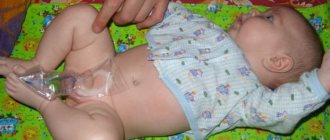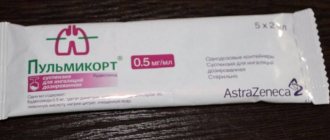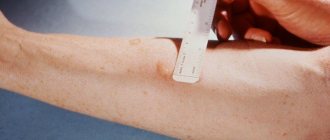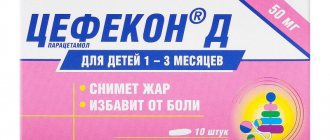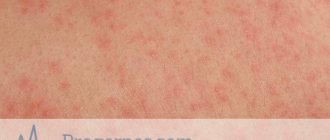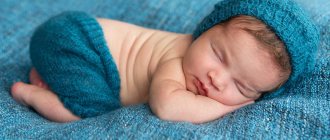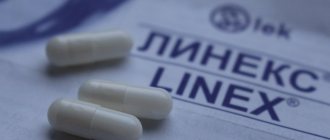Inhalation is an effective method of treating diseases of the throat and respiratory system, especially if carried out using a nebulizer inhaler. This method is available to everyone, including children. Of the numerous medications used for inhalation, Dioxidin is the most effective. The drug is characterized by excellent antibacterial action. It easily copes with pathogenic bacteria, which are poorly affected by other, even the most powerful antibacterial agents, and quickly stops inflammation. By inhalation, the drug enters the lower part of the respiratory tract and, thanks to this, has a beneficial effect on all respiratory organs.
Treatment of cough in a child at home: what you need to know
Inhalation is one of the most effective, but, unfortunately, almost forgotten method of treating both dry and wet cough in children. The main advantage of this treatment is its local effect: the child’s other organs are not stressed, which greatly reduces the likelihood of complications.
A dry cough is often much more painful, and it is more difficult to tolerate than a wet cough. Therefore, the main goal of treatment for dry cough is to soften it, after which the treatment process is significantly accelerated.
A wet cough is much more productive than a dry cough. It quickly removes mucus from the lungs and stops tormenting the baby. Inhalation for a child’s wet cough is just as effective as for a dry cough - the sputum, liquefied by steam, will clear the lungs faster.
What to do with inhalations: making the treatment as effective as possible
If your child suffers from a dry and annoying cough (unless this cough, of course, is caused by an inflammatory process in the larynx), then alkaline components are perfect. To do this, add 2-3 teaspoons of baking soda to the water. For the best effect, you can add a few drops of oregano to the soda solution.
For dry coughs, the “grandmother’s” method of treatment also works great - inhaling the vapors of potatoes boiled in their jackets.
If your child has a wet cough, we recommend adding herbs and essential oils to the water.
If a wet cough is complicated by a runny nose, inhalations with the addition of eucalyptus or propolis are suitable, which will not only relieve nasal swelling, but will also act as anesthetic medications.
Procedure: how to do it correctly
Steam inhalation is carried out over a pan of hot water with a volume of about 1 liter, into which medicinal substances are added. The child should tilt his head over the pan and cover it with a towel, which ensures that the temperature of the inhaled steam is maintained at the proper level. During the procedure, you must breathe only through your mouth. The duration of it for a child should be from 3 to 8 minutes and no less than 2 hours after a meal, and the frequency should not exceed 2 times a day.
Note that when carrying out steam treatment at home, it is important to choose the right water temperature . Only adults can perform inhalations over a pan of boiling water; in young children, such procedures can result in burns to the mouth and respiratory tract. The ideal water vapor temperature for children under one year of age is 30 degrees Celsius, for children from one to 3 years old – up to 40 degrees.
It is important to note that inhalations are contraindicated at elevated body temperature, heart disease and a tendency to nosebleeds .
When carrying out the procedure, you need to consider the following nuances:
- Inhalation requires holding your breath while inhaling for approximately 2 seconds;
- The child's clothing should be loose and not restrict him;
- After inhalation, it is recommended to spend at least an hour in peace, without straining your throat.
Herbal inhalation recipes:
- Peppermint and garlic. Add 2 teaspoons of peppermint to boiling water. Heat over low heat for 5-7 minutes. Then strain and add a pre-ground clove of garlic;
- Chamomile. Add 1 tablespoon of crushed chamomile flowers to boiling water. Heat over low heat for about 20-30 minutes.
Recipes for inhalation with essential oils:
- 2-3 drops of frankincense, ginger or cypress essential oil per liter of water;
- 3-5 drops of rosemary or bergamot essential oil per liter of water;
- 5-7 drops of eucalyptus or sandalwood essential oil per liter of water.
By combining proven folk remedies, you will relieve your child of an annoying cough in a short time.
Diseases of which cough is a symptom are very common in childhood.
One of the methods of their treatment is inhalation, which helps moisturize the mucous membranes, reduce inflammation, make sputum more liquid and improve coughing, which speeds up recovery.
Medicinal properties and features of inhalations
What is inhalation?
Inhalation should be understood as inhalation of a sprayed liquid or vapor for several minutes. The term is derived from the Latin word inhalo, which translates as inhale. With the development of new technologies, such treatment procedures are becoming more accessible and effective, because today you can either inhale vapors naturally or use all kinds of inhalers.
List of indications for inhalations
Wet, thermo-moist and simple steam inhalations work well for the following disorders:
- acute respiratory viral infections with symptoms such as rhinitis, tracheitis, laryngitis and pharyngitis;
- complications after ARVI in the form of laryngotracheitis and rhinosinusitis;
- tonsillitis, sinusitis, rhinitis during exacerbation;
- respiratory disorders due to progression of HIV infection;
- difficulty breathing due to bronchial asthma;
- prevention of complications after operations;
- certain stages of pneumonia;
- cystic fibrosis disease;
- bronchitis in acute or aggravated chronic form;
- bronchial tuberculosis;
- pulmonary tuberculosis;
- bronchiectasis pulmonary disease;
- spread of fungal microflora within the lower and upper respiratory tract.
As you can see, inhalations can improve the condition of a whole range of serious diseases. It is also important to consider that there are restrictions when you cannot inhale medicinal vapors.
List of contraindications for the inhalation procedure
In case of the following deviations, it is not recommended to do inhalation, so as not to provoke deterioration:
- bleeding in the lungs;
- individual negative reaction of the body to the components of medications;
- pneumothorax of traumatic or spontaneous etiology;
- bullous pulmonary emphysema;
- complex heart failure;
- hypertension;
- Heart arythmy;
- stroke;
- myocardial infarction;
- increased body temperature;
- purulent sore throat.
If you have an allergic rhinitis, you need to approach the issue of inhalation with caution, since only procedures with a nebulizer are indicated. Moreover, the device must not be ultrasonic. And steam inhalations for such ailments contribute to increased swelling of the nasal mucosa. From the above it follows that in case of severe illnesses, treatment measures must be agreed upon with the attending physician.
Inhalations against cough
If you inhale correctly when coughing, you can get the following positive effects:
- acceleration of recovery and rapid relief from diseases of the respiratory system;
- intensive hydration of the mucous membranes of the respiratory tract and temporary relief of a dry, debilitating cough;
- increased secretion of sputum during a wet cough and thereby protection from the development of complications or transformation of the disease into a chronic type;
- Thanks to the stimulation of sputum formation, an irritating dry cough is quickly replaced by a lighter, wet one.
It is for these reasons that doctors often prescribe various inhalations along with the main treatment. It is important that in complex cases of illness, the attending physician decides whether inhalation can be done for a runny nose and cough, and indicates which medications are best to use.
Inhalations for a runny nose
How do inhalations work for a runny nose?
- softening crusts of dried mucus in the nasal passages;
- complete hydration of the nasal mucosa;
- immediate relief of itching and dryness in the nose;
- thinning the consistency and accelerating the natural removal of mucus;
- steam treatment of the upper bronchi.
After several sessions, you can restore normal nasal breathing and feel much better.
How to do inhalations at home?
To get an idea of the pros and cons of a particular inhalation method, you need to try a course of treatment at home and evaluate the effect. There are generally accepted rules that reveal how to do inhalation yourself in order to get only the benefits. Let's look at them further.
If inhalation is carried out using the traditional method, then it is necessary to inhale steam at normal temperature so as not to burn the mucous membrane.
Today, more and more people are purchasing nebulizers for home to increase the efficiency of inhalation. If in life this procedure is combined with physical activity or eating, then you need to take a break of one and a half hours after these actions.
During any inhalation, you should focus on the process, not talk or read. If you cannot radically overcome nicotine addiction, you should give up smoking at least for as long as you are taking the inhalation course.
Comfortable clothing that does not restrict movement in the neck area will make breathing easier. It is also obvious that for problems with the nose, such as pathologies of the sinuses and various diseases of the nose, nasal inhalation works best. This means that aerosols are inhaled through the nose. It’s good that attachments and masks have been developed for this purpose.
If you are concerned about disorders in the pharynx, bronchi, trachea, lungs, larynx, then the therapeutic aerosol is inhaled through the mouth. Systematic breathing should consist of moderately deep breaths. Each breath is done like this: inhale, hold your breath for a couple of seconds, and finally exhale slowly through your nose.
Of course, before using a pharmaceutical drug, you need to carefully study the information on the packaging and read the composition. We also note that experts often point out the incompatibility of solutions for inhalation with drugs to facilitate the release of sputum and antiseptic rinses for treating oral growth.
You can complete your regular home inhalation by rinsing with lukewarm boiling water. When the procedure is done through a mask, it is advisable to rinse your eyes and mouth.
After the procedure, you must refrain from talking, smoking, eating and drinking for 20-60 minutes. The number of procedures varies individually, but is usually limited to three sessions of therapeutic inhalations per day.
Doctors warn that inhalation is dangerous to carry out at elevated body temperatures. When using inhalers, you need to thoroughly disinfect after each session.
One procedure can last about 10-15 minutes.
If a child is being treated, then we are talking about 1-3 minutes. It is optimal to arrange 1-2 inhalations during the day. Inhalations for a runny nose and cough: speed up recovery and protect against complications
Indications and contraindications
Children may be prescribed inhalations for the following diseases:
- For cough caused by ARVI.
- For acute bronchitis.
- For laryngitis and pharyngitis.
- For bronchial asthma.
- During the recovery period from pneumonia.
- For tuberculosis or cystic fibrosis.
Inhalations cannot be carried out:
- Children under one year old.
- Children with bacterial sore throat.
- At elevated body temperature.
- Children with otitis media.
- In case of intolerance to the drug.
- For frequent nosebleeds.
- When coughing with pus or blood.
- In serious condition.
Additional recommendations for runny nose and cough for children
- Air humidity plays a big role in the treatment, as well as in the prevention of runny nose and cough in a child. For a speedy recovery of the patient, it is recommended to maintain a relative humidity in the room of about 70%, as well as an air temperature of up to 22 °. Under such conditions, phlegm and mucus are freely removed from the body naturally, without complicating breathing.
- If there is no elevated body temperature for more than 3 days, walks in the fresh air are recommended, which also improves the secretion of mucus in the upper respiratory tract.
- Shoulder exercises, as well as massage, will help remove remaining mucus from the bronchi mechanically in the shortest possible time.
Share the article on social media. networks:
( 5 ratings, average: 5.00 out of 5)
Why is the procedure performed for coughing?
Inhalations have the following effect:
- Stimulates mucus secretion during dry cough.
- Softens sputum and makes it easier to expectorate during a wet cough.
- Prevents the spread of infection into the lower respiratory tract.
- Bacteria and dead leukocytes are removed from the respiratory tract.
- Reduce the risk of complications.
- Increase blood flow in the lung tissue.
- Activate metabolic processes in the mucous membranes of the respiratory tract.
Inhalation and bathing with a dry cough cause copious sputum production, so these procedures must be carried out with caution. For more information about this, see Dr. Komarovsky’s program.
Inhalation with a nebulizer
Using a nebulizer for procedures allows you to spray medicinal substances into tiny droplets and deliver them into the respiratory tract to the place where their action is important. For its operation, such a device can use ultrasound, a compressor or a special membrane.
Depending on the particles generated in the device, nebulizer inhalations can be directed to different parts of the respiratory tract. Medicines transferred into small particles will quickly enter the tissues of the respiratory system, and will also act on them longer and more effectively than with other methods of administration.
Solutions specially designed for use in such a device are poured into the nebulizer. Most often they are diluted in saline solution, and the use of herbal decoctions and oil solutions in most nebulizers is prohibited. Some models also have restrictions for medications, such as corticosteroid hormones.
The following substances are used for inhalation when coughing:
- Products that help moisturize and soften mucous membranes. These include salt and mineral water, saline solution, water with soda. Such moisturizers are especially often prescribed for dry coughs.
- Medications with a bronchodilator effect that help eliminate spasms in the respiratory tract. This group of drugs includes Berotec, Atrovent, Berodual and Ventolin. They are recommended for dry and allergic coughs.
- Agents with mucolytic action. Such drugs are Ambrobene, ACC, Bronchipret, Lazolvan, Mucaltin and others. They are indicated for both wet and dry coughs.
- Anti-inflammatory agents to reduce swelling and inflammation. This effect is provided by Tonzilgon N, Pulmicort, Cromohexal, Rotokan and other drugs. They are recommended for barking, allergic and wet coughs.
- Antitussive agents. These include Lidocaine and Tussamag. Such drugs are prescribed for barking cough.
- Antiseptic agents for cleansing mucous membranes. This group includes Chlorophyllipt, Furacilin, Miramistin and Dioxidin. Their purpose is indicated for wet or barking cough.
- Medicinal herbs with mucolytic, anti-inflammatory and emollient effects. Such herbs include sage, chamomile, coltsfoot, St. John's wort, mint, thyme and others. Their decoctions are used for dry coughs.
- Essential oils with anti-inflammatory and softening effects. This effect is observed in oils of pine, sea buckthorn, eucalyptus, almond and others. Inhalations with them are recommended for dry cough.
For information about why you should not do inhalations with boiled potatoes, see Dr. Komarovsky’s program.
Cough is one of the symptoms of many viral and bacterial respiratory tract infections: pharyngitis, tracheitis, bronchitis, pneumonia. The cough can be dry and wet (with sputum). One of the tasks in the treatment of these diseases is to thin the mucus and improve its elimination.
Inhalation therapy plays an important role in the treatment of respiratory pathologies. The advantage of the inhalation method of drug administration is the direct effect of the drug on the inflamed mucous membrane of the respiratory system and the spasmodic muscles of the bronchi.
Steam inhalations.
Our grandmothers used this method in the good old days. Today it is not as popular as it used to be. This is due to the fact that steam inhalers have been replaced by new, more convenient and effective inhalers, or so-called nebulizers. But more about them a little later. Let's talk a little about steam inhalations.
Steam inhalations are carried out using a steam inhaler made of heat-resistant medical plastic, which can be bought at a pharmacy, or in the “old-fashioned” way over a saucepan, covered with a towel. For treatment, medicinal herbs, essential oils or medications are used, such as: a mixture for inhalation, ammonia-anise drops, and breast elixir. The therapeutic effect is achieved by the direct effect of steam-humid air and medicinal aerosols on the mucous membrane of the upper respiratory tract.
Steam-moist inhalation of medicinal aerosols helps moisturize the mucous membrane, improve blood circulation, activate the function of the ciliated epithelium, thin out viscous mucus, facilitate sputum discharge, soothe dry cough, and reduce the feeling of dry throat.
Mode of application. 300 - 350 ml of a previously prepared decoction of medicinal herbs is poured into a pan container and brought to a boil. Or boiling water is poured into the inhaler container, to which 1-2 drops of a drug solution or 1-2 drops of essential oil are added. This could be fir, pine, peppermint or juniper oil, tea tree oil, a mixture of essential oils for coughs or a mixture of essential oils for colds. An adapter with a mask attached to it is fixed to the container. The inhaler is ready for use. For a more complete penetration of the aerosol from the inhaler into the respiratory tract, tight contact with the mask is necessary.
Inhalations should be carried out while sitting, in a position comfortable for you, in a calm state, half an hour before meals, or 30 minutes after meals. Breathing should be calm and uniform. Inhalations are carried out 2 times a day for 15 minutes. The course is prescribed from 5 to 15 inhalations.
Medicinal plant materials that can be used for inhalation:
- Eucalyptus leaf
- sage leaf
- Peppermint leaf
- Coltsfoot leaf
- Chamomile flowers
- Pine buds
- Thyme herb
- Oregano herb
- Grass succession
- Chest collection No. 4
I use medicinal plants or their preparations in dried and crushed form: 1-2 tablespoons per 250 ml of boiling water.
Contraindications. High body temperature (over 37.50C); allergic reactions to medications, essential oils or herbs; tuberculosis; nosebleeds.
Please note: Be careful when the inhaler is filled with hot water; Do not leave children receiving inhalation unattended!
Use of nebulizers
For inhalation, there is a special device - a nebulizer, which converts the liquid medicine into tiny droplets (5-10 microns in diameter), which penetrate into the lungs when inhaled.
The pharmacy chain sells 2 types of nebulizers - compression and ultrasonic. Compression devices are larger in size and make noise during operation. Ultrasonic nebulizers are small, compact, and operate silently, but they are not designed to administer antibiotics and hormones (ultrasound destroys them).
Nebulizers can be used at home. The special mask included in the kit is intended for use on small children.
The use of inhalation treatment makes it possible to:
- eliminate inflammation;
- moisturize the mucous membrane during a dry cough (soften it);
- relieve bronchospasm;
- facilitate the discharge of sputum;
- shorten the duration of the illness.
Inhalation is a safe and effective treatment method for cough in children.
Steam inhalation (inhalation of vapors over a saucepan or kettle) is dangerous due to the risk of burns to the oral or nasal mucosa. The use of a nebulizer does not pose such a danger: its effect does not consist in warming up the mucous membrane of the trachea or bronchi with hot steam, but in delivering a sprayed medicinal product to the inflamed organ, including the lungs.
Why you can’t do inhalation for cough and runny nose at the same time
The nebulizer includes several different attachments. There are masks for adults and children. Their use helps to breathe therapeutic vapors in the most natural way possible, usually used for very young children or seriously ill adults.
For a more concentrated effect on diseased parts of the child’s respiratory system when coughing and runny nose, the nebulizer has a nasal cannula and a mouthpiece (mouthpiece). Their use allows you to direct a medicinal stream directly to the site of localization of the inflammatory process.
The combined use of two attachments is impossible and contraindicated. If it is necessary to treat a runny nose and cough at the same time, it is necessary to carry out inhalations at different times, with a minimum interval of 20 minutes.
Article design: Mila Friedan
Drugs used in nebulizers
Any medications for inhalation should be prescribed by a pediatrician. The doctor will determine the dosage of the drug depending on the nature of the lesion and the severity of the disease, and the age of the child. The frequency of inhalation should also be agreed with your doctor.
Using a nebulizer you can administer:
- bronchodilators or bronchodilators (used to relieve bronchospasm, an attack of bronchial asthma, dry cough): Berotek, Berodual, Salbutamol, Salgim, Truvent, Atrovent, etc.;
- hormones (for the treatment of bronchial asthma): Pulmicort;
- antibiotics and antiseptics (prescribed for bacterial infections - tonsillitis, pharyngitis, bronchitis): Furacilin, Dioxidin, Gentamicin, Miramistin, etc.;
- mucolytics (thinning sputum): Pulmozim, Lazolvan, Fluimucil, Ambrobene, Pertussin, Mucaltin, Sinupret (homeopathic drug);
- anti-inflammatory drugs: Rotokan, Malavit, Propolis, Tonsilgon N, Chlorophyllipt, herbal remedies - calendula, eucalyptus, etc.;
- immunomodulatory agents – interferon;
- moisturizing mucous membranes: mineral waters (previously degassed) Borjomi, Narzan or saline solution.
If it is necessary to use inhaled drugs of different directions of action, it is necessary to correctly follow the order of their use:
- First, inhalation should be carried out with a bronchodilator (medicine that dilates the bronchi);
- After 20 minutes, you can use mucolytics (sputum thinners).
- After half an hour, you can inhale antiseptics.
- Medicines with anti-inflammatory effects are allowed to be inhaled without an interval after antiseptics.
- Immunomodulators are used at the end of a course of therapeutic inhalations or for the purpose of prevention.
Rules for using a nebulizer
We have written in detail about the rules for using a nebulizer for children and adults in this article.
- Only drugs intended for inhalation through a nebulizer should be used.
- The solution for inhalation must be sterile.
- Before use, the solution should be warmed to room temperature.
- The prescribed amount of the drug is poured into a special cup of the device and placed in the nebulizer.
- For older children, a breathing mouthpiece is used; for children, a special mask is used.
- After each inhalation, the mouthpiece (mask) and cup are thoroughly rinsed with water.
- It is undesirable to use aromatic oils and suspensions through a nebulizer, as this may damage it.
- Pharmacies sell ready-made medicinal mixtures for inhalation through a nebulizer. It is better to use these special solutions or powders, which are pre-dissolved with saline solution. If herbal medicines or a solution from a tablet are prepared at home, then the prepared product should be filtered so that there are no sediments that could spoil the device.
Mesh - nebulizers.
The most expensive inhaler, which does not have the disadvantages of the above-described inhalers. It is compact and very effective. When the mesh-membrane vibrates under the influence of ultrasound, an aerosol is formed, the particles of which have different sizes. This size can be adjusted by changing membranes for targeted delivery of the drug to those parts of the respiratory tract where it is needed. The sound is low-frequency, so the structure of the medicinal substance is not disturbed. Any medicine can be used.
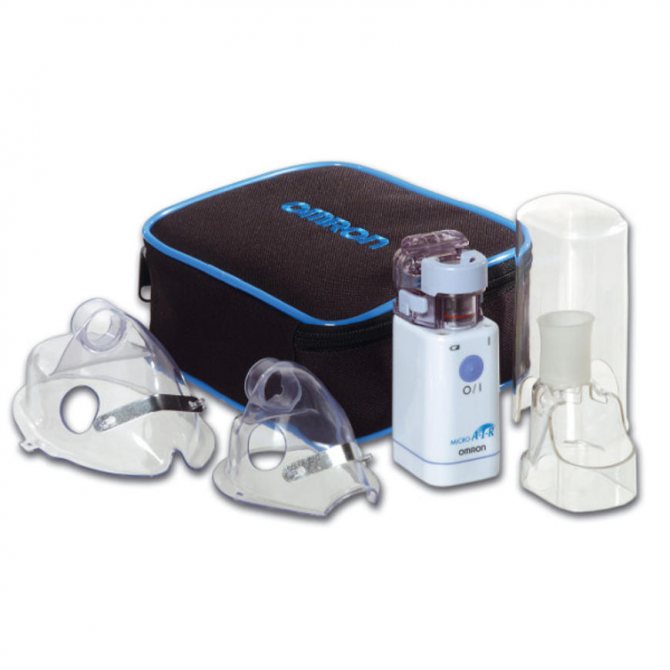
Currently, a nebulizer is a very popular device. Millions of people have already experienced its effectiveness. There are a huge number of positive reviews. Using an inhaler, the duration of colds and the incidence of respiratory diseases are significantly reduced. Excellent treatment for cough and runny nose. When you decide to purchase an inhaler, be sure to read the instructions or consult a specialist to make the right choice. Use only those medications that have been prescribed by your doctor and approved for use with this inhaler.
Summary for parents
Colds and inflammatory diseases of the respiratory system are a fairly common pathology in children, especially in the off-season and cold season. Doctors often recommend using inhalations as an effective treatment method.
Since the frequency of inhalations to achieve effectiveness should be 3-4 times a day, it is unrealistic to go to a physiotherapy room for procedures.
For every family with children, a nebulizer will become an indispensable device that facilitates the child’s treatment process. The device is quite simple to use, but you should not select medications for inhalation and their doses yourself, so as not to harm the child’s health.
How to give inhalations to a child when he or she coughs and what regimen to follow, the program “Doctor Komarovsky’s School” tells:
A fragile child's body is constantly faced with viruses and bacteria. Children who have started attending general education institutions - kindergarten or school - get sick especially often.
When your own immunity begins to produce antibodies, viral infections weaken and their symptoms gradually disappear. The task of parents is to ease the course of the disease as much as possible in order to speed up recovery. The most common respiratory manifestations of seasonal diseases are runny nose, cough, and sore throat.
In young children, the airways are not yet sufficiently developed; their openings are much narrower than in adults. Children have difficulty clearing their throat, especially if the mucus is thick. To prevent thickening of mucus in the nasal passages and bronchi, first of all, ensure the correct drinking regime. You need to drink a lot, all drinks must be heated. Compotes made from dried fruits, fruit drinks, and tea with honey are especially useful. You can drink juice, mineral or regular water. If a child refuses to drink, he should be given a little drink, offering a teaspoon of the drink every 10 minutes.
Increasingly, instead of taking cough medicine orally, children are using an inhalation solution. This is an effective and convenient method for treating diseases of the upper and lower respiratory tract.
Indications
A nebulizer for children against cough and runny nose can be used almost unlimitedly, starting from birth.
Aerosol inhalations are used in the following cases:
- for the treatment or prevention of diseases of the nasopharynx - swelling, runny nose, sinusitis, as well as acute respiratory infections, ARVI;

- with pharyngitis, laryngitis, tracheitis (inflammatory process in the middle parts of the respiratory system);
- from bronchospasms;
- for bronchitis, pneumonia, asthma (pathology of the lower respiratory tract);
- from allergies manifested by coughing, sneezing, inflammation and sore throat;
- to maintain the respiratory system in the postoperative period.
Nebulizer inhalations allow you to deliver medicinal particles to the lowest parts of the bronchopulmonary system. Applicable for some gastrointestinal pathologies, when treatment is impossible in the usual way.
Help of inhalations
Unlike syrups and tablets, inhalations for coughs in children act directly on the tissues of the respiratory organs. A modern inhaler delivers medicine directly to the bronchi and lungs. At the same time, auxiliary synthetic components do not enter the baby’s gastrointestinal tract, liver and kidneys.
In some cases, devices for inhalation therapy are simply necessary. They are used in hospitals to relieve obstruction, bronchospasm and laryngospasm that can occur when a child has a strong cough. At home, inhalers make life much easier for patients with bronchial asthma.
A properly selected inhalation solution for cough has several therapeutic effects:
- Helps transform a dry cough into a productive wet cough
- Liquefies mucus in the bronchi, facilitating coughing
- Relaxes and opens the airways, facilitating easy removal of mucus
- Relieves spasm and feeling of suffocation
- Stops inflammatory processes
- Improves blood circulation and oxygen saturation of lung tissues
- Reduces the risk of infection entering the lower respiratory tract.
Indications and contraindications.
Inhalation therapy is used to treat acute and chronic diseases of the respiratory tract, accompanied by accumulation of sputum, runny nose, difficulty breathing, spasm:
- ARVI
- Laryngitis, tracheitis
- Bronchitis
- Pneumonia
- Allergies
- Bronchial asthma
- Cystic fibrosis.
A simple procedure and a large selection of safe drugs make it possible to perform cough inhalations even for young children. Contraindications for use are:
- Children up to one year of age (in rare cases, prescribed to babies from 6 months)
- High body temperature
- Significantly weakened condition
- Inflammatory processes in the ear area (otitis media)
- Bacterial laryngitis, tonsillitis, lacunar or follicular tonsillitis
- Tendency to nosebleeds
- Hemoptysis
- Individual intolerance to components.
Rules for the procedure.
Only a pediatrician can prescribe cough treatment and select a solution after examination and diagnosis.
Important! The components, dosage, duration of the procedure and frequency of administration are prescribed by the doctor! Self-medication can be dangerous.
In order for the treatment to be effective and the inhaler device to serve for many years, it is necessary to follow some rules:
- Cough inhalation solution for children is prepared with precise proportions.
- It is necessary to observe the shelf life of the finished mixture.
- The procedure is carried out an hour before or an hour after meals.
- The room is pre-ventilated.
- The patient takes a sitting or standing position.
- The duration of the procedure does not exceed 5 minutes for younger children and 15 for older ones.
- To achieve a good therapeutic effect, a course of procedures is carried out for 3-5 days, 3 times a day.
- The equipment must be in good working order and clean. After each use, clean the inhaler according to the instructions.
- For children, only individual masks and mouthpieces are used.
Advantages of inhalers
At home where there are children, it won't hurt to have an inhaler. After all, with its help, various medications can be administered to the source of infection - the nose, throat or lungs.
It should be noted that aerosols and sprays with sea water and an isotonic solution are used to treat rhinitis. The volume varies - from 20 to 500 ml. These include AquaLor, Aquamarine, Quix, Otrivin Sea. This form of release is very convenient in terms of compactness in relation to devices. This is especially felt in the treatment of young children. Also, such aerosols are much cheaper than inhalers. The doctor must take this into account, because the financial issue plays an important role when developing a treatment plan.
For the treatment of rhinitis and pharyngitis, you can use the antiviral immunomodulator human leukocyte interferon, Derinat, saline solution, alkaline mineral water without gas, antimicrobial drugs such as Miramistin, Dioxidin.
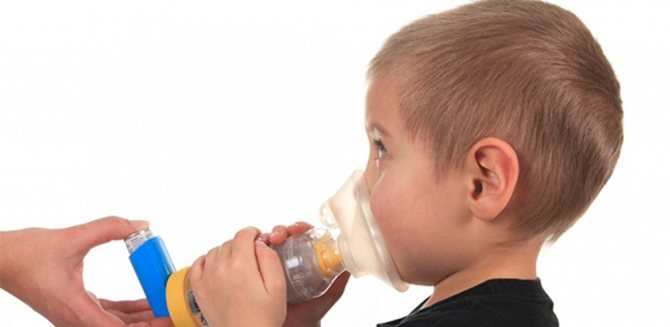
If a child has a cough, mucolytics are prescribed to thin the child and mucokinetics to remove sputum.
Inhaled hormonal drugs are used for bronchial asthma and to eliminate laryngeal edema during croup, which often occurs in young children.
In relation to children, oils are rarely poured into the inhaler (more precisely, they are not used at all) due to the risk of developing “oil pneumonia” due to the sticking together of small bronchioles and alveoli under the influence of an oil solution (although compressor inhalers allow the use of oils). If you prepare decoctions and infusions of medicinal plants for inhalation yourself at home, it is important that the prepared solutions are carefully filtered.
For prolonged use of inhalers, be sure to follow the instructions for use and follow the instructions to avoid breakdowns.



